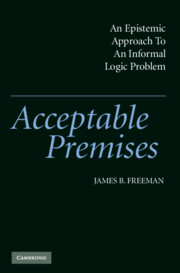Book contents
- Frontmatter
- Contents
- Preface
- Acknowledgments
- PART 1 ACCEPTABILITY: DIALECTICAL AND EPISTEMOLOGICAL COSIDERATIONS
- PART 2 STATEMENTS, BELIEF-GENERATING MECHANISMS, AND PRESUMPTIVE RELIABILITY
- PART 3 PRACTICE AND PERSPECTIVE
- 11 An Outline of the Practice of Epistemic Casuistry
- 12 Theoretical Considerations: A Commonsense Foundationalism
- Notes
- References
- Index
11 - An Outline of the Practice of Epistemic Casuistry
Published online by Cambridge University Press: 02 December 2009
- Frontmatter
- Contents
- Preface
- Acknowledgments
- PART 1 ACCEPTABILITY: DIALECTICAL AND EPISTEMOLOGICAL COSIDERATIONS
- PART 2 STATEMENTS, BELIEF-GENERATING MECHANISMS, AND PRESUMPTIVE RELIABILITY
- PART 3 PRACTICE AND PERSPECTIVE
- 11 An Outline of the Practice of Epistemic Casuistry
- 12 Theoretical Considerations: A Commonsense Foundationalism
- Notes
- References
- Index
Summary
Some premises are straightforwardly acceptable as basic premises without argument either presenting evidence for the premises or a case for their being justified in this instance. For example, given how a challenger is appeared to perceptually, she may be perfectly justified in her immediate acceptance of a premise expressing a perceptually generated descriptive belief. However, suppose one is faced with a “hard” case. One may feel constrained to justify to oneself that a statement is acceptable as a basic premise. Alternatively, one may need to show to someone else why a statement is acceptable – or not acceptable – as a basic premise under prevailing conditions. Here the request is to justify the judgment that a particular statement is or is not acceptable as a basic premise. Apart from the dialectical requirement of showing someone that a statement is acceptable, the epistemological issue remains of why one is justified in accepting a particular premise in a certain situation.
At the risk of raising hackles in some, we call making such a determination an exercise in epistemic casuistry. There is no need for hackles to be raised, given the way we use the word. For “casuistry” as we understand it means no more than what we have indicated – making determinations in particular cases. In its ordinary, moral context, casuistry deals with such questions as whether a particular act is right or wrong, or a particular state of affairs good or bad.
- Type
- Chapter
- Information
- Acceptable PremisesAn Epistemic Approach to an Informal Logic Problem, pp. 319 - 366Publisher: Cambridge University PressPrint publication year: 2004



